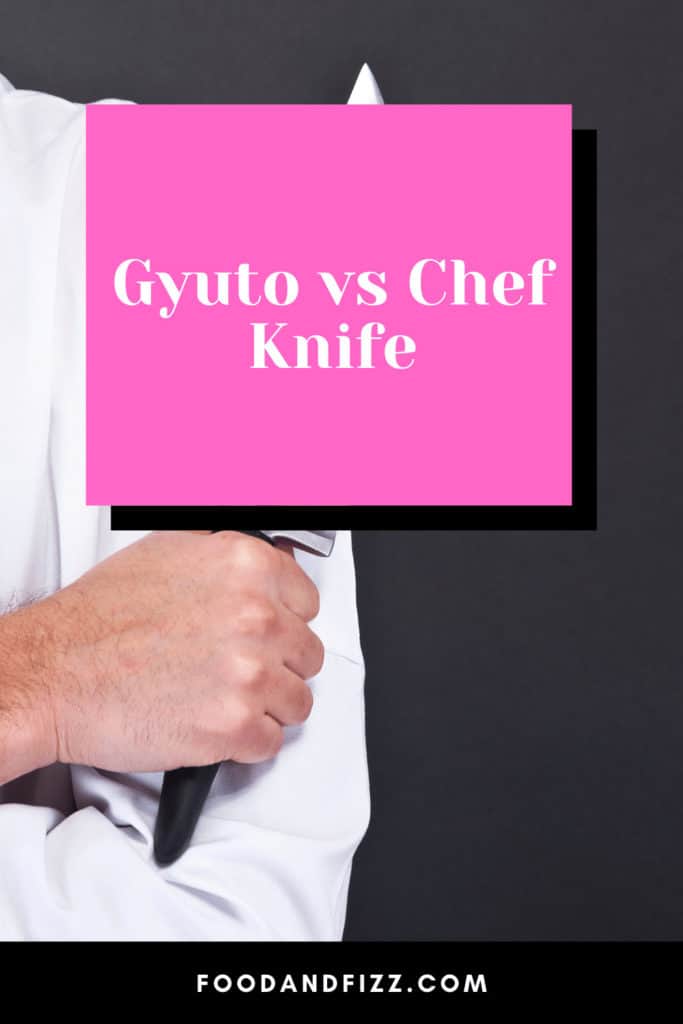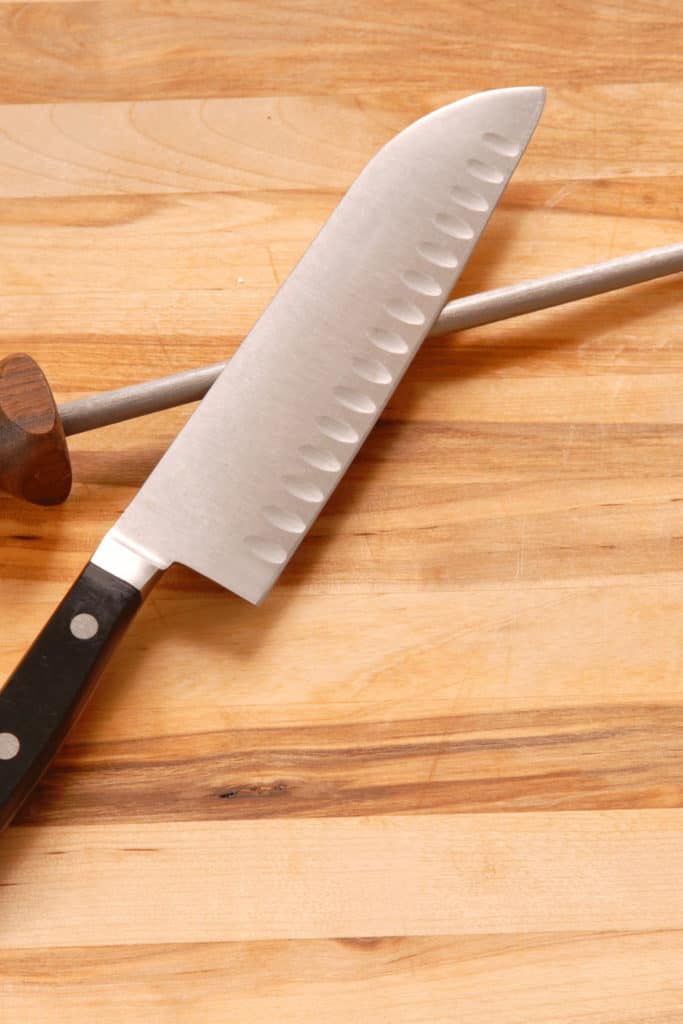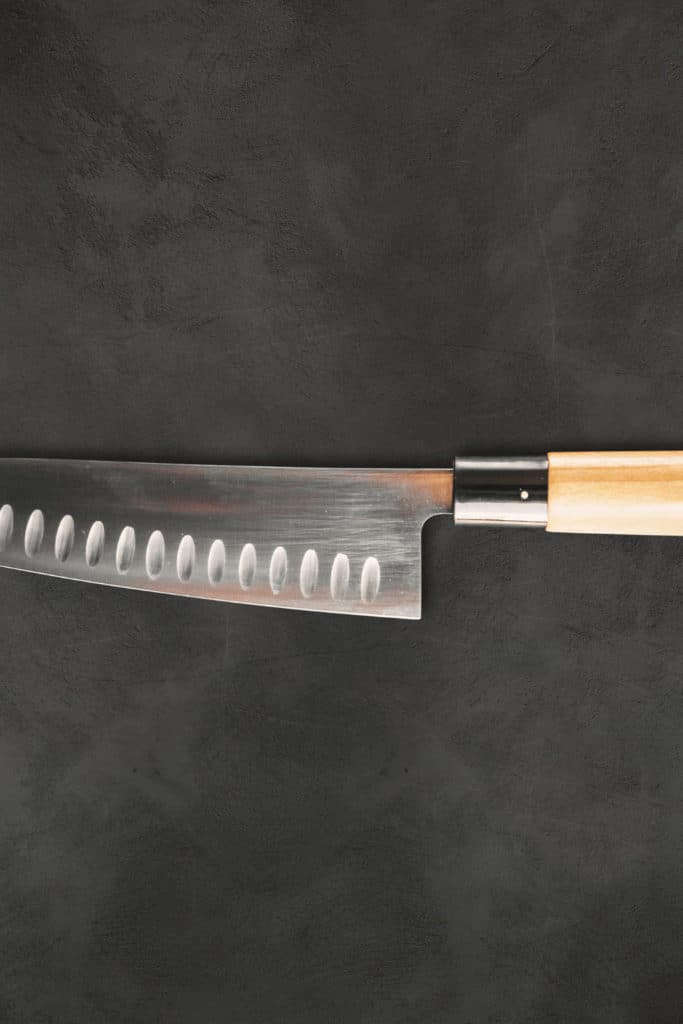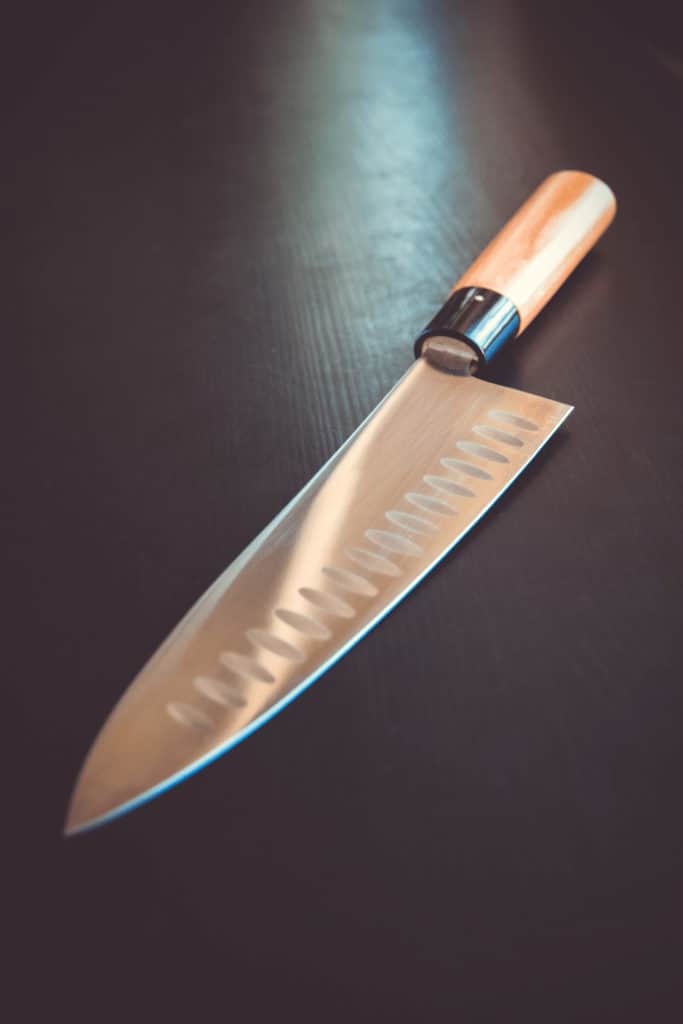Going shopping for a new knife for my kitchen was a lot more challenging than I expected.
I was specifically looking for a versatile knife, which led me to the Gyuto vs chef knife.
They looked virtually the same, so what was the difference between a chef knife and a Gyuto knife?
I called one of the knowledgeable-looking shop assistants over to help, and here’s what I learned.
Gyuto vs Chef Knife
The Japanese Gyuto knife and the Western chef knife generally look similar and can be used for the same purposes in a kitchen. In terms of differences, the Gyuto knife’s blade is generally between 6-12 inches long and made from hard AUS-10, SG-2, or VG10 steel, while the chef knife’s blade is between 8-14 inches long and made from stainless steel, ceramic, carbon steel, or high-carbon stainless steel.

Gyuto vs Chef Knife
The ambidextrous, more heavyweight chef knife is easier to sharpen because the blade is double-beveled and sharpened at an angle of 20-22 degrees.
The lightweight Gyuto is a single-edge that’s traditionally only suitable for right-handed cooks, difficult to sharpen, and razor-sharp at a 15-18 degree angle.
The synthetic or wooden handle of the Gyuto is made for a pinch or fingertip grip because it’s oval or octagonal, while the synthetic, plastic, steel, or wooden handle of the chef knife is double-riveted for comfort and durability.

The Gyuto vs Chef Knife: A Short Look At the Histories
Gyuto is a Japanese word meaning “cow sword” and this gives us an indication of the knife’s intended purpose.
The Gyuto knife was originally meant to be used to slice meat – specifically beef.
However, the knife has evolved as most things do and is a versatile tool in kitchens these days with its sharp edge so you can cut more than just beef.
On the other hand, the roots of the chef knife can be traced to 1773 Germany.
These knives are popular and known for being sharp, heavy, and tough.
The Western chef knife can be used to slice and chop almost anything, from meat to veggies and fruit.
The Gyuto was created as a Japanese version of the Western chef knife that retains its unique Japanese qualities.

The Similarities Between a Chef Knife vs Gyuto Knife
Here are the similarities between a Gyuto and a chef knife:
Similarity 1: Knife Uses
Since the Gyuto is pretty much a Japanese version of the Western chef knife, both knives are multipurpose cutting tools.
While there are some finer differences in terms of the uses, in broad strokes, what you can do with the chef knife, you can do with the Gyuto:
- Slice meats
- Chop, mince, dice, and slice herbs, veggies, fruit, boneless meat, and fish
- Thrust-cut or tap-chop vegetables
The biggest difference is that you can make more precision cuts with the Gyuto blade than with the chef knife.

Similarity 2: Looks
At a glance, the chef knife and the Gyuto look identical. However, there are details that are different if you are detail-oriented.
The Differences Between a Gyuto vs Chef Knife
Here are the differences between a Gyuto and a chef knife before I look at which one you need in your kitchen:
Difference 1: Blade Material
Gyuto blades are generally made from AUS10A steel, SG2 steel, or VG-10 steel, while chef knife blades are made from ceramic, stainless steel, carbon steel, or high-carbon stainless steel.
The Gyuto blades hold an edge for longer and these blade materials are more resistant to wear.
On the other hand, chef knives may be more resistant to corrosion if the blade is stainless steel, but ceramic blades, while capable of holding an edge well, chip easily.
Carbon steel blades may need maintenance to prevent stains and rust.

Difference 2: Blade Size
Gyutos have shorter blades than chef knives. The blade length of a Gyuto ranges from 6-12 inches.
Use shorter blades to cut the garlic, chicken bits, and ginger, and use longer blades to disjoint meat, dice vegetables, and slice fruit.
Chef knife blade lengths range from 8-14 inches, and the 14-inch chef knife is ideal for professional butchers.
Difference 3: Blade Sharpness and Bevel
The chef knife is generally sharpened at an angle of 20-22 degrees on both sides of the blade because the blade edge is double-bevel or double-angled.
This means the edge of the blade is sharpened to the same angle on both sides.
A double-bevel knife is also an ambidextrous knife, so a left-handed cook and a right-handed cook can comfortably cut and slice with the Western chef knife.
The Gyuto is traditionally a single-bevel or single-angled blade, so it’s only sharpened at an angle of 15-18 degrees on one side.
Depending on which edge is sharpened, only a right-handed user or left-handed user can use the knife.

These days, double-beveled Gyuto knives are available, meaning that both lefties and righties can use the same Gyuto knife.
Difference 4: Handle Design
The steel, plastic, wood, or synthetic handle of a chef knife is generally more durable and comfortable with a double riveted style.
Some handles are ergonomic to reduce hand and wrist fatigue while you use the knife.
The Gyuto knife handle is made from wood or synthetic material with an octagonal or oval design.
The part of the handle that’s closest to the blade – the kakumaki – has a wrap that’s smooth for extra comfort.
Difference 5: Handle Gripping Style
It’s recommended to use the fingertip and pinch grip styles with a Gyuto blade because the knife is lightweight and won’t cause discomfort.
The fingertip grip is ideal for the rock-chop technique because placing your index finger on the blade’s spine gives you more control over the ingredients.
With the chef knife, use a pinch grip at the handle, bolster, or blade.

Difference 6: Weight
Compared to a Gyuto, a chef knife is heavier to help you rock-chop more easily.
If you need to cut through small bones, you can do so using the heel of the knife. Plus, the thicker knife spine helps you break down poultry.
A lightweight Gyuto is ideal for slicing rather than chopping, especially since the spine is thinner.
Difference 7: Blade Sharpening
Chef knife blades are easier to sharpen. About 10 strokes on a stone are enough to sharpen this blade.
Sharpening a Gyuto blade isn’t easy and requires a whetstone and about 15 minutes – provided you know-how.
Is a Chef Knife or Gyuto Knife Best for Your Kitchen?
Whether a Gyuto vs a chef knife is best depends on your personal preference, your budget, what you will use the knife for most, and whether you are left-handed or right-handed.
Gyuto Blade Pros
- Easy to handle
- Versatile, better suited for slicing and precision cuts
- Very sharp blade
- Can use a pinch and fingertip grip
Gyuto Blade Cons
- Need to make sure it’s made for a right- or left-handed person, or double-beveled
- Not easy to sharpen the blade
- More expensive than a chef knife
Chef Knife Pros
- Durable
- Easy to handle with good balance feel
- Multipurpose, better suited for chopping
- Easy to sharpen
- Less expensive than a Gyuto
- Ambidextrous
Chef Knife Cons
- Blade isn’t as sharp
- Not ideal if you need to cut precisely

Frequently Asked Questions About Gyuto vs Chef Knife
Do you need a Santoku and a Gyuto?
If you don’t have a big budget, then it’s best to get a Santoku, which is a multipurpose knife with a wide, flat, sharp blade. The less expensive Santoku is ideal for making long, precision cutting strokes or transferring food. A Gyuto looks like a Western chef’s knife that has a sharper tip. Use the Gyuto blade for rock chop techniques, slicing meat, and crushing foo
What is a Gyuto knife used for?
Gyuto blades are multipurpose Japanese chef knives used to crush, mince, slice, dice, and chop ingredients, disjoint and debone the meat, create pockets in meat, and cut vegetables and fruit with a firm texture.
What is another name for a chef’s knife?
A chef’s knife is also known as a cook’s knife, which is a cutting tool used in the preparation of food in commercial and home kitchens. Originally, the chef knife was used to disjoint and cut beef, but these days, the knife is a versatile cutting tool in kitchens.
The Final Verdict: Gyuto vs Chef Knife
For versatile kitchen knives, you can’t go wrong if you choose a chef knife or a Gyuto knife.
You can actually even buy both – a shorter Gyuto for more precision cutting and a longer-blade chef knife for chopping meat and slicing through a honey melon.
Which multipurpose “chef” knife do you prefer?

